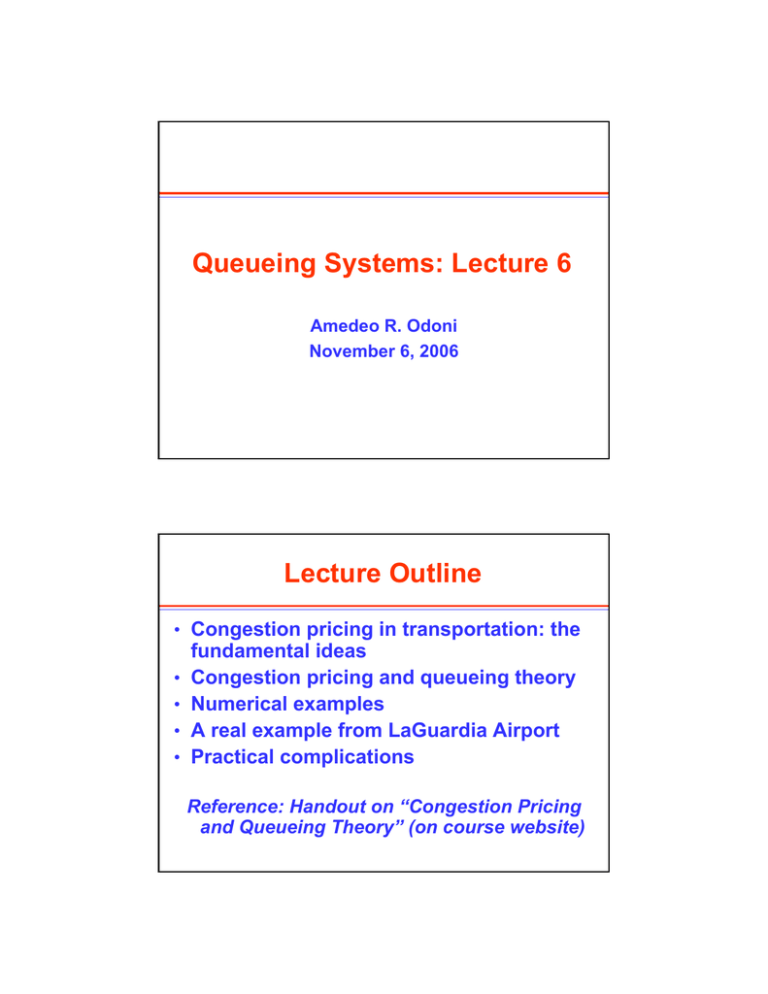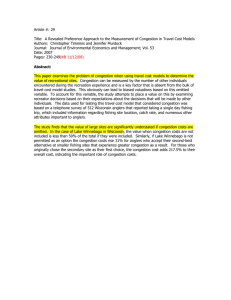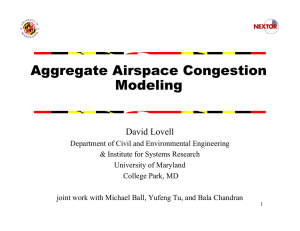Queueing Systems: Lecture 6 Lecture Outline
advertisement

Queueing Systems: Lecture 6
Amedeo R. Odoni
November 6, 2006
Lecture Outline
• Congestion pricing in transportation: the
fundamental ideas
• Congestion pricing and queueing theory
• Numerical examples
• A real example from LaGuardia Airport
• Practical complications
Reference: Handout on “Congestion Pricing
and Queueing Theory” (on course website)
Congestion pricing: The basic observation
• The congestion costs due to any specific user
have 2 components:
(1) Cost of delay to that user (internal cost)
(2) Cost of delay to all other users caused by that user
(external cost)
• At congested facilities, this second component
can be very large
• A congestion toll can be imposed to force
users to experience this cost component (to
“internalize the external costs”)
Economic principle
Optimal use of a transportation facility cannot be
achieved unless each additional (marginal)
user pays for all the additional costs that this
user imposes on all other users and on the
facility itself. A congestion toll not only
contributes to maximizing social economic
welfare, but is also necessary to reach such a
result. (Vickrey, 1967, 1969; Carlin + Park,
1970)
Two hard technical problems
• In practice it is very hard to:
(1) Estimate external marginal delay costs
(extensive data analysis and/or simulation
have been typically needed – subtle issues);
(2) Determine equilibrium congestion tolls (trial
and-error approach that may take long time to
converge)
• Queueing theory has much to offer (especially
with regard to the first problem) under certain
conditions.
Computing Internal and External Costs
Consider a queueing facility with a single type of users in
steady-state. Let
c = delay cost per unit time per user
C = total cost of delay per unit time incurred in the system
Then:
C = cLq = cλWq
and the marginal delay cost, MC , imposed by an
additional (“marginal”) user is given by:
MC =
Marginal
cost
dW q
dC
= c W q + cλ
dλ
dλ
Internal
cost
External
cost
Numerical Example
• Three types of aircraft; Poisson; FIFO service
_ Non-jets: λ1 = 40 per hour; c1 = $600 per hour
_ Narrow-body jets: λ2 = 40 per hour; c2 = $1,800 per hour
_ Wide-body jets: λ3 = 10 per hour; c3 = $4,200 per hour
_ Total demand is: λ = λ1 + λ2 + λ3 = 90 per hour
• pdf for service times is uniform
_ U[25 sec, 47 sec]
_ E[S] = 36 sec = 0.01 hour; μ = 100 per hour
σ S2 =
22 2
= 40.33 sec 2 = 3.11213×10 −6 hours 2
12
• Note: We have a M/G/1 system
Numerical Example [2]
Wq =
λ ⋅[E 2 [S] + σ S2 ] 90 ⋅[(0.01) 2 + 3.11213×10 −6 ]
=
≈ 0.0464 hours ≈ 167 sec
2 ⋅ (1 − ρ )
2 ⋅ (1 − 90 /100)
λ
λ1
λ
+ c 2 2 + c3 3
Define: c = c1
λ
λ
λ
C = c ⋅ Lq = c ⋅ λ ⋅Wq = (c1 ⋅ λ1 + c 2 ⋅ λ2 + c3 ⋅ λ3 ) ⋅Wq = c ⋅Wq
Or: C = c ⋅Wq = ($138,000) ⋅ (0.0464) = $6,400
E 2 [S] + σ S2 λ ⋅[E 2 [S] + σ S2 ] 1
=
+
⋅ ≈ 5.1556 ×10 −6 hours ≈ 18.6 sec
2
2 ⋅ (1 − ρ )
μ
dλ
2 ⋅ (1 − ρ )
dWq
Numerical Example [3]
dWq
dC
= c1 ⋅Wq + c ⋅
≈ $28 + $711 = $739
dλ1
dλ
internal
cost
external cost=
congestion toll
dWq
dC
= c 2 ⋅Wq + c ⋅
≈ $85 + $711 = $796
dλ2
dλ
dWq
dC
= c3 ⋅Wq + c ⋅
≈ $198 + $711 = $909
dλ3
dλ
Generalizing to m types of users…
• Facility users of type i: arrival rate
service time
λi
;
−1
Si with μ i = E[Si ] ;
cost per unit of time in the system
ci
• For entire set of facility users, we have
m
1
λ = ∑ λi
μ
i= 1
m
λ
ρ = = ∑ ρi =
μ i= 1
λ
∑ μi
i =1
i
m
= E [S ] =
m
⎛ λi
∑ ⎜⎝ λ
i =1
×
1 ⎞⎟
μ i
⎠
⎛ λi ⎞
ci
⎝
⎠
i= 1 λ
m
c=∑
Generalization (continued)
• As before: C = cLq = cλ W q
giving:
MC(i) =
dW q
dC
= ci W q + c λ
dλ i
dλ i
• When we have explicit expressions for Wq, we
can also compute explicitly the total marginal
delay cost MC(i), the internal (or private) cost
and the external cost associated with each
additional user of type i
Example
For an M/G/1 system:
MC(i) =
λ ⋅ E[S ]
dC
= ci
+ cλ
d λi
2(1 − ρ )
2
(1 − ρ )E[S i2 ] +
λ
E[S 2 ]
μi
2(1 − ρ ) 2
• Can extend further to cases with user priorities
Finding Equilibrium Conditions
and Optimal Congestion Tolls!
We now generalize further: let xi be the total cost
perceived by a user of type i for access to a congested
facility and let λi (xi ) be the demand function for type i
users.
x i = IC i + CTi + K i
ICi = internal private cost; it is a function of the demand
rates, λi (xi )
CTi = congestion toll imposed; equal to 0 in absence of
congestion tolls; can be set arbitrarily or can be set as a
function of the λi (xi ) under congestion pricing schemes
Ki = any other charges that are independent of level of
congestion
Finding Equilibrium Conditions and Optimal Congestion Tolls! [2]
• With m types of users, the equilibrium conditions for any set of demand functions, can be found by solving simultaneously the m equations: ⎛ m
⎞ dWq [λ̂ ( x̂ )]
xi = ci ⋅Wq [λˆ ( xˆ )]+ ⎜ ∑ c j ⋅ λ j x j ⎟ ⋅
+ Ki
⎜
⎟ dλ i ( x i )
⎝ j =1
⎠
( )
where
λ̂ (x̂) = {λ1 (x1 ), λ2 (x2 ),..., λm (x m )} .
The missing piece: Demand functions can only be roughly estimated, at best!
∀i
An illustrative example from airports
Service rate
(movements per hour)
Standard deviation of
service time (seconds)
Cost of delay time
($ per hour)
Type 1
(Big)
80
Type 2
(Medium)
90
Type 3
(Small)
100
10
10
10
$2,500
$1,000
$400
Hypothetical Demand Functions
λ1 (x1 ) = 40 − 0.001⋅ x1 − 0.00001⋅ x12
λ2 (x 2 ) = 50 − 0.003 ⋅ x 2 − 0.00002 ⋅ x22
λ3 (x3 ) = 60 − 0.01⋅ x3 − 0.00008 ⋅ x32
40
50
60
0,001
0,003
0,01
0,00001 0,00002 0,00008
lambda 1 lambda 2 lambda 3
40
50
60
39,8
49,5
58,2
39,4
48,6
54,8
38,8
47,3
49,8
38
45,6
43,2
37
43,5
35
35,8
41
25,2
34,4
38,1
13,8
32,8
34,8
0,8
31
31,1
-13,8
29
27
-30
26,8
22,5
-47,8
24,4
17,6
-67,2
21,8
12,3
-88,2
19
6,6
-110,8
16
0,5
-135
12,8
-6
-160,8
9,4
-12,9
-188,2
5,8
-20,2
-217,2
2
-27,9
-247,8
-36
-280
00
20
00
00
18
16
14
00
00
12
00
20
0
0
Type 1
Type 2
Type 3
10
10
80
20
0
30
0
40
60
50
40
60
0
100
200
300
400
500
600
700
800
900
1000
1100
1200
1300
1400
1500
1600
1700
1800
1900
2000
0
Arriv al rate (Users/unit tim e)
70
0
Demand Functions for three types of users
x
Total cost ($)
Case 1: No Congestion Fee
No Congestion Fee
(1) Delay cost (IC) per aircraft
(2) Congestion fee
(3) Total cost of access
[=(1)+(2)]
(4) Demand (no. of movements
per hour)
(5) Total demand (no. of
movements per hour)
(6) Expected delay per aircraft
(7) Utilization of the airport
(% of time busy)
Type 1
Type 2
Type 3
$1,802
$0
$1802
$721
$0
$721
$288
$0
$288
5.7
37.4
50.5
93.6
43 minutes 15 seconds
99.2%
Case 2: Optimal Congestion Fee
Optimal Congestion Fee
(8) Delay cost (IC) per aircraft
(9) Congestion fee (CF)
(10) Total cost of access
[=(1)+(2)]
(11) Demand (no. of
movements per hour)
(12) Total demand (no. of
movements per hour)
(13) Expected delay per
aircraft
(14) Utilization of the airport
(% of time busy)
$135
$853
$988
$54
$750
$804
$22
$670
$692
29.2
34.6
14.9
78.7
3 minutes 15 seconds
89.9%
70
o
o+
40
30
20
Type 1
Type 2
Type 3
+
+
10
o
Total cost ($)
00
00
18
16
00
14
00
12
00
0
0
10
80
60
0
40
0
0
0
00
50
20
60
20
Arrival rate (Users/unit time)
Demand Functions for three types of users
o
+
No Fee
With Fee
Important to note…
• The external costs computed in the absence
of congestion pricing give only an upper
bound on the magnitude of the congestionbased fees that might be charged
• These are not necessarily “equilibrium
prices”
• Equilibrium prices may turn out to be
considerably lower than these upper
bounds
• Equilibrium prices are hard to estimate,
absent knowledge of demand functions
Case of LaGuardia (LGA)
• Since 1969: Slot-based High Density Rule (HDR)
DCA, JFK, LGA, ORD; “buy-and-sell” since 1985
Early 2000: About 1050 operations per weekday at LGA
April 2000: Air-21 (Wendell-Ford Aviation Act for 21st Century)
_ Immediate exemption from HDR for aircraft seating 70 or fewer pax
on service between small communities and LGA
By November 2000 airlines had added over 300 movements per
day; more planned: virtual gridlock at LGA
December 2000: FAA and PANYNJ implemented slot lottery and
announced intent to develop longer-term policy for access to LGA
Lottery reduced LGA movements by about 10%; dramatic reduction
in LGA delays
June 2001: Notice for Public Comment posted with regards to
longer-term policy that would use “market-based” mechanisms
Process stopped after September 11, 2001; re-opened in 2004
_
•
•
•
•
•
•
•
Scheduled aircraft movements at LGA
before and after slot lottery
120
Scheduled
100
movements
Nov, 00
Aug, 01
per hour
81 flights/hour
80
60
40
20
0
5
7
9
11
13
15
17
19
21
23
1
3
Time of day (e.g., 5 = 0500 – 0559)
Estimated average delay at LGA
before and after slot lottery in 2001
100
Average
delay
(mins
per
movt)
Nov, 00
Aug, 01
80
60
40
20
0
5
7
9
11
13
15
17
19
21
Time of day
23
1
3
LGA: Marginal delay caused by an
additional operation by time of day
16
Nov, 00
Marginal 14
delay
12
(Aircraft
hours)
Aug, 01
10
8
6
4
2
0
5
7
9
11
13
15
17
19
21
23
1
3
Time of day of incremental operation
(e.g., 5 = 0500-0559)
LGA: Marginal external delay cost per additional
movement vs. average landing fee per movement
$5,000
Marginal
$4,500
delay cost $4,000
($ per
movt)
Aug, 01
Landing fee
$3,500
$3,000
$2,500
$2,000
$1,500
$1,000
$500
$0
5
7
9
11
13
15
17
19
21
Time of day
23
1
3
Issues that arise in practice
-- Toll may vary in time and by location
-- Facility users may be driven by “network”
considerations
-- “Social benefit” considerations
-- Political issues
-- What to do with the money?



